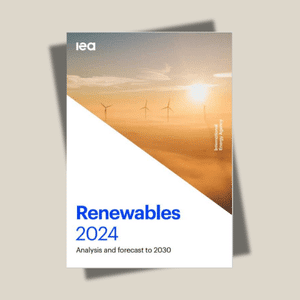
The IEA says Net Zero remains in reach and would benefit from a biomethane boost
The International Energy Agency’s (IEA) Renewables 2024 report delivers a much-needed injection of optimism for the global renewables sector and calls for a global effort to realise the potential of bioenergy and biofuels.
The report forecasts that renewables will generate almost half of the global electricity demand by the end of 2030, with the world edging closer to the COP28 target of tripling renewable energy capacity by the end of the decade.
The IEA predicts that by 2030 the world will have added 5,500 Gigawatts of new renewable energy capacity – roughly equivalent to the current power systems of the United States, China, the European Union and India combined – close to meeting the COP28 target of tripling world renewable energy capacity by the end of this decade, to keep net zero within reach.

Dr Fatih Birol, Executive Director of the IEA said, “We are not yet exactly there but we are very close.” In an optimistic press conference, he referenced investor action as a positive signal and suggested that there could be more good news ahead. “Looking at market trends and the appetite from investors around the world, I wouldn’t be surprised if next year there will be more positive surprises coming.” Dr Birol stressed that the rise in renewables is driven by economics rather than climate policies.
First for Biogas and Biomethane
For the first time in the IEA renewables market report series, the annual report features a special chapter on renewable fuels, including bioenergy, biogases, hydrogen, and e-fuels. It forecasts their role in global energy demand by 2030 and their potential for decarbonising the industry, building, and transport sectors.
The report says that “global demand for biogases (including both biogas and biomethane) is expected to accelerate, climbing an estimated 30% in the period 2024-2030 to reach almost 2 270 PJ (around 59 bcme) per year in 2030.” But this is way short of what is required to deliver net zero.
The report states, “Current global production expansion is not in line with the IEA Net Zero by 2050 Scenario, which requires the production of biogases to grow 3.7-fold by 2030. Despite accelerated growth in the main-case forecast, 2030 demand of 2 750 PJ/year falls 64% short of what is needed in the Net Zero by 2050 Scenario.”
Biomethane Growth drivers
To meet the Net Zero goal the report “will require all countries to increase their ambitions and resolve implementation challenges. Many regions with strong biogas potential, such as Latin America and Southeast Asia, could make significant contributions to global growth if their countries introduce new policies to support the biogas sector.”
In 2024-2030, the transport sector leads demand growth for biogases owing to significant support in countries and regions such as India, the European Union and the United States. In these geographies, “the lower carbon intensity of biomethane made from wastes and residues (compared with other biofuels) and the reduction of methane emissions from livestock when processing animal manure remain key drivers for the use of biogases”.
The section in the chapter on Biofuels that addresses ‘Biogases’ (biogas and biomethane) runs across pages 157-72. This includes snapshots of the market conditions, key drivers and anticipated growth in Europe – focusing on Germany, France and Italy – the US, China and India. The word biogases is mentioned 33 times in the report, biomethane 79 times.
Bridging the biogas gap
The growth forecasts given vary significantly by country reflecting the different production and demand policy tools and incentives. In its earlier report, COP28 Tripling Renewable Capacity Pledge Tracking; Countries’ Ambitions and Identifying Policies to Bridge the Gap report the IEA said bioenergy is the most overlooked technology.
It identified 124 countries as having bioenergy capacity installed but that only 31 have set explicit ambitions for 2030. This is partly because of ‘general’ recording of data, e.g. solid biomass is included in co-firing, and waste energy and biogases are combined with hydrogen or other gases.
Taking a more granular and standardised approach to auditing the different energy vectors emerging from the bio-economy sector would enable countries to be more aware of their potential capacity and how it can best be realised.

